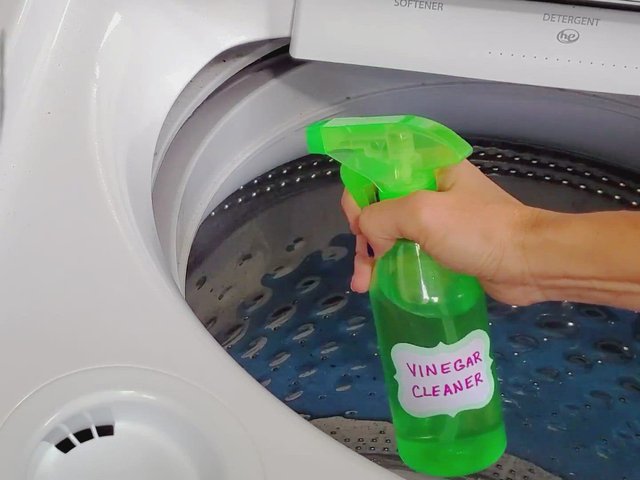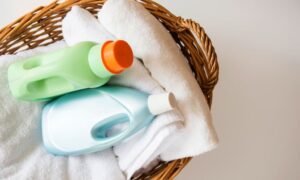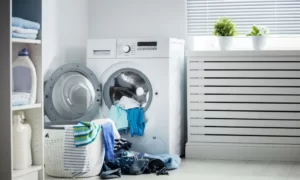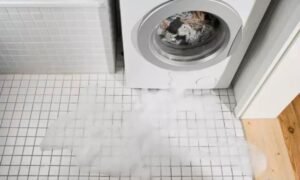Last updated on June 25th, 2023 at 04:18 am
Your washing machine is essential for keeping your clothing fresh and clean, but what happens when it picks up stubborn stains? Due to numerous variables including detergent building, mineral deposits, or mold development, your machine may eventually acquire residue buildup, odours, or even produce stains on your garments. For your washing machine to operate at its best and to keep your laundry clean, you must know how to remove these difficult stains from it successfully. In this manual, we’ll look at how stains in your machine happen, how to prevent them, how to get rid of stubborn stains, and how to troubleshoot typical problems. You can prevent stains in your washing machine and guarantee that your laundry is always clean and crisp by using these tricks and suggestions. Let’s dig in and learn how to get rid of stubborn stains from your washing machine.
the Causes of Tough Stains
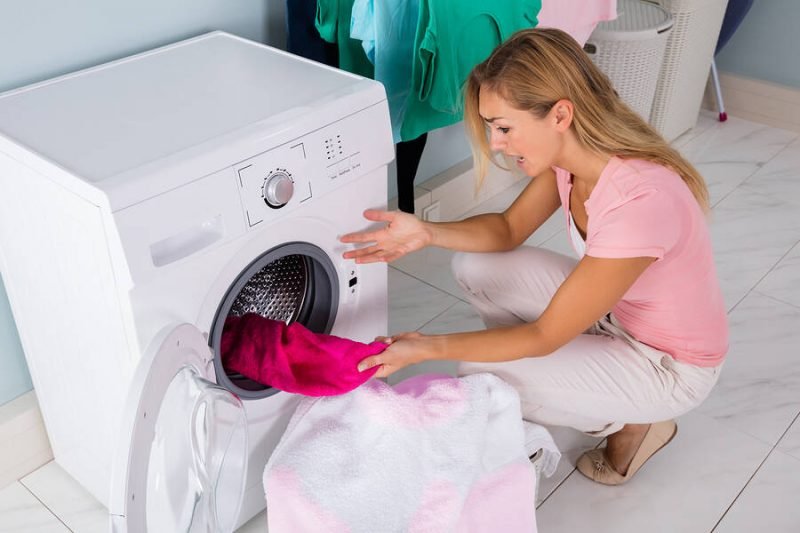
Photo Credit: itisfixed
Exploring Different Types of Stains
Organic Stains: These stains are brought on by biological materials including food, blood, grass, and other organic things. Organic stains sometimes include pigments or natural dyes that can bind to the fabric’s fibers and make the removal challenging.
Inorganic Stains: Non-living materials including rust, mineral deposits, dye, ink, and other manmade materials are responsible for inorganic stains. These stains frequently come about as a result of chemical reactions or when chemicals deposit on surfaces.
Identifying the Stains’ Sources
Clothing: The kind of fabric, its color, and any treatments the cloth has had can all have an impact on how stains react with the garment. Some textiles could be more susceptible to stains because of their texture or absorbency. Additionally, some dyes or treatments could make stains more challenging to get rid of.
Water Quality: The staining process may be impacted by the quality of the water used during washing or cleaning procedures. Hard water may leave behind deposits on surfaces and textiles that cause stains or discoloration because it has a high mineral content, including calcium and magnesium.
Cleaning Products: The type of cleaning products used can also impact stain removal. There may be certain compounds or chemicals in detergents, bleach, fabric softeners, and other cleaning products that are intended to target particular sorts of stains. However, certain treatments might not work against specific stains or, if applied incorrectly, might potentially harm the material or discolor it.
Understanding the causes of tough stains and identifying their sources can help in choosing the appropriate cleaning methods and products to effectively remove the stains while minimizing any potential damage to the stained material.
Preventive Measures for Stain Removal
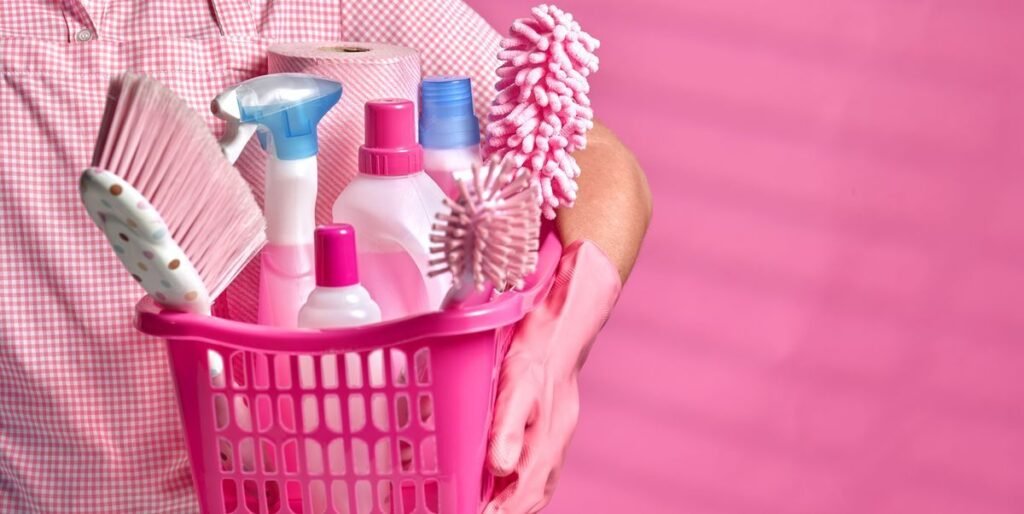
Photo Source: goodhousekeeping
Sorting and Pre-Treating Stained Clothes
Sorting by Color, Fabric, and Stain Type: It’s important to sort your clothes before washing them to prevent color bleeding and ensure proper stain treatment. To prevent dye transfer between clothing, arrange items according to color. To avoid damage, keep delicate materials separate from stronger ones. Group things with like stains together as well for more focused cleaning.
Pre-Treating with Stain Removers or Natural Remedies: Before washing, pre-treat stained areas to increase the chances of successful stain removal. There are several stain removers on the market that are made to work on particular kinds of stains. As an alternative, you may remove stains naturally by using baking soda, vinegar, or lemon juice. Directly apply the selected therapy to the discoloured region and let it sit for a while before cleaning.
Proper Detergent and Additive Selection
Choosing Detergents for Different Stain Types: Select a detergent that is specifically formulated to tackle the types of stains you commonly encounter. Consider using enzyme-based detergents for protein-based stains like blood or grass, and look for detergents that mention stain removal on their labels. To guarantee correct use, read the directions on the detergent container.
Utilizing Enzymatic Cleaners and Boosters: Enzymatic cleaners contain enzymes that break down specific types of stains, making them more effective for stain removal. These cleansers can be used to your usual detergent as a supplement. Boosters like oxygen bleach or hydrogen peroxide can also aid in the removal of tough stains and the whitening of materials. For appropriate usage, adhere to the following instructions.
Regular Maintenance and Cleaning Routine
Cleaning the Drum and Dispenser Drawers: To prevent the accumulation of detergent residue, fabric softener, or other materials that might transfer onto clothing and produce stains, regularly clean the drum and dispenser drawers of your washing machine. If required, use a light detergent and a moist cloth or sponge to clean these surfaces.
Descaling to Remove Mineral Deposits: If you have hard water, mineral deposits can accumulate in your washing machine over time, leading to stains on clothes. Descale your machine on a regular basis with a descaling product or vinegar and water. For further information on descaling, consult the owner’s handbook for your washing machine.
Preventing Mold and Mildew Formation: Mold and mildew can cause stains and unpleasant odors on clothes. After each usage, keep the washing machine door open to let air circulate and dry off any moisture to stop their creation. Additionally, avoid keeping damp garments in the washing machine for a lengthy amount of time. If you spot mould or mildew, you should use a mold and mildew cleaner or a water and bleach solution to clear the afflicted areas.
You may reduce the likelihood of stains on your garments by using these preventative methods, and you can ensure that stains are removed from them more successfully when you wash them.
Effective Techniques for Removing Tough Stains
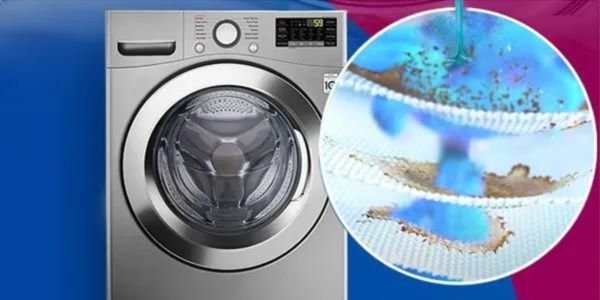
Photo Source: bigbasket
Removing Organic Stains
Treating Food and Beverage Stains: For food and beverage stains, start by blotting the stain with a clean cloth or paper towel to remove any excess. Then, give the discoloured area a few minutes of cold water soaking. Use a gentle detergent or a stain remover made especially for food stains to gently massage the spot. You may also attempt using a paste comprised of baking soda and water for tough stains. Wash the item as directed by the care label after giving it a good rinse.
Eliminating Blood and Protein Stains: Blood stains should be treated as soon as possible. Start by removing as much blood as you can from the discoloured area by washing it with cold water. Then, let the clothing soak for 30 to 60 minutes in a solution of cold water and enzyme-based detergent. You can soak the item in a solution of cold water and hydrogen peroxide before washing if the blood stain is more ingrained or difficult to remove.
Tackling Grass, Mud, and Dirt Stains: Gently scrape off any excess grass, mud, or dirt from the stained area using a blunt knife or spoon. Use a stain remover or a paste created by combining water and laundry detergent to pre-treat the stain. After applying the mixture to the stain, let it set for approximately 15 minutes. Follow the care recommendations and wash the item in the warmest water safe for the fabric.
Battling Inorganic Stains
Removing Rust Stains: Rust stains can be challenging to remove. Making a paste with salt and lemon juice (or vinegar) is one efficient technique. A few hours should pass after the paste has been applied on the stain. Use a brush or sponge to gently scrub the stain, then thoroughly rinse. A professional rust remover made especially for textiles is another option.
Dealing with Mineral Deposits and Limescale: Combine equal volumes of white vinegar and water to remove mineral deposits and limescale stains. Spend a few hours or the entire night soaking the discoloured area in the solution. Use a soft brush or sponge to gently scrub the stain, then thoroughly rinse. Use a commercial descaler as directed by the product’s instructions or repeat the procedure if necessary.
Handling Dye and Ink Stains: Rub or isopropyl alcohol can be used to remove ink stains. Avoid rubbing the stain deeper into the fabric by dampening a clean cloth with alcohol and dabbing it on the spot. Blotting should be kept up until the stain is removed. Apply a little quantity of liquid dish soap or a stain remover to the discoloured area and gently massage it in if the stain is caused by dye. After a thorough rinse, wash the item as directed on the label.
Always examine the garment’s care label and try any stain removal technique or product on a tiny, discrete area first to be sure it won’t harm the fabric or fade the colour. For optimum results, adhere to the detailed directions listed on the stain remover or cleaning product.
Common Stain Removal Challenges: Troubleshooting
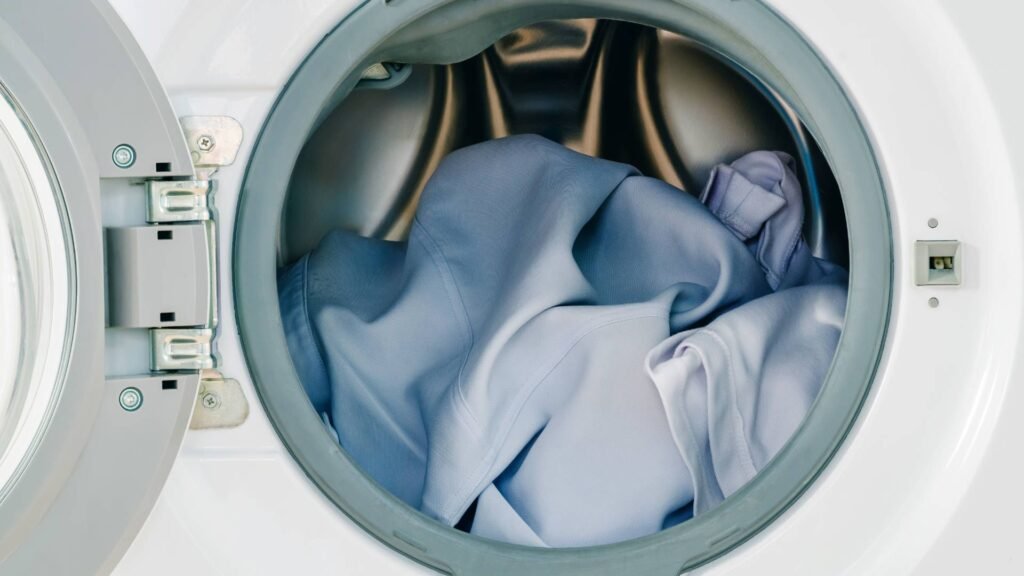
Photo Source: authorized
Residual Odors in the Washing Machine
Identifying the Source of Odor: Residual odors in the washing machine can be caused by various factors, such as bacteria, mold, mildew, or detergent buildup. Examine the machine’s drum, rubber gasket, and detergent dispenser for any obvious mould or mildew growth to determine where the smell is coming from. Additionally, see whether the machine has any retained stagnant water.
Deodorizing with Natural and Synthetic Methods: To start, run an empty cycle with two cups of white vinegar and hot water. This aids in destroying any residue and eradicating any germs or mold. Alternatively, you can use a commercially available cleanser or deodorizer according to the product’s directions. Running a cycle with baking soda can also help eliminate odors naturally. Don’t forget to clean the detergent dispenser, rubber gasket, and drum afterwards to get rid of any leftover dirt.
Stubborn Stains that Resist Treatment
Investigating Advanced Stain Removal Methods: There are a few advanced methods you may attempt if a stain is proving to be really difficult to remove. Making a paste out of hydrogen peroxide and a tiny bit of ammonia is one possibility. After applying the paste to the stain and letting it sit for a short while, thoroughly rinse the area. Another approach is to apply an enzyme-based cleaning or fabric-safe stain remover and let it sit on the spot for a long time before washing. You can also think about using a stain-removal instrument made particularly for textiles, such as a soft-bristled brush or a stain eraser.
Getting Professional Assistance and Repair Services: It could be wise to get professional assistance if everything else fails and the stain lingers or if you’re working with delicate or priceless clothing. Professional dry cleaners are skilled at removing stains and are capable of handling tough stains. Make careful to let them know the type of stain and any prior attempts at remediation. Furthermore, if your washing machine isn’t working correctly or has odour problems that just won’t go away, it could need expert repair or maintenance services. For assistance, get in touch with the manufacturer or a reputable appliance repair company.
When tackling difficult stains or odour problems, it’s crucial to be persistent and patient. Not every stain can be entirely eliminated, especially if it has penetrated the cloth deeply if the item is made of fragile or sensitive fabric. Regular washing machine maintenance and quick stain removal might assist to avoid these problems altogether.
Tips for Maintaining a Stain-Free Washing Machine
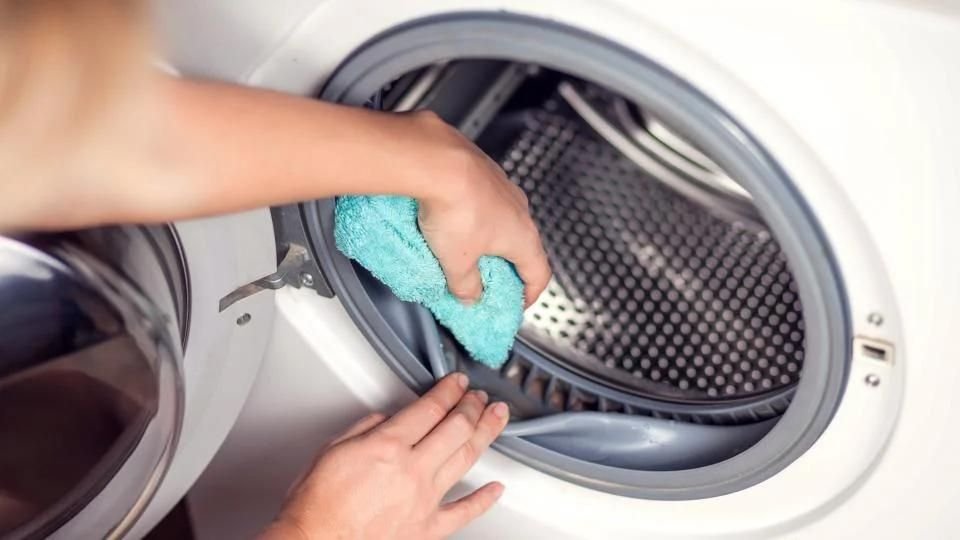
Photo Source: expertreviews
Regular Maintenance Checks and Inspections
Examining Hoses, Filters, and Seals: Routinely look for wear or leaks in the hoses that connect to your washing machine. Make sure the filters are clean and debris-free by checking them. Additionally, look for any indications of damage or mold development in the seals that surround the machine’s door or lid.
Checking for Leaks and Malfunctioning Parts: Keep an eye out for any water leaks during the washing cycle or when the machine is not in use. Make that there are no leaks or loose connections in the water intake and drain hoses. It is advised to have a qualified expert examine and fix the equipment if you detect any broken parts or strange noises.
Recommended Cleaning Products and Techniques
Using Vinegar, Baking Soda, or Citric Acid: Regularly clean your washing machine to prevent the buildup of residue and odors. As natural cleaning agents, you can use baking soda, white vinegar, or citric acid. Add two cups of white vinegar or half a cup of baking soda to an empty cycle and run the machine on the hottest setting for a quick clean-up. Alternately, you can use the washing machine cleansers on the market that are based on citric acid.
Applying DIY Cleaning Solutions and Homemade Remedies: There are various DIY cleaning solutions and homemade remedies you can try to clean your washing machine. To clean the machine, for instance, you may combine equal parts water and bleach and run a cycle. Cleaning the machine’s outside surfaces with a solution of water and dish soap is an additional alternative. For any special cleaning advice or safety measures, always refer to your machine’s handbook.
Best Practices for Stain Prevention
Immediately and Properly Treating Stains: Treat stains as soon as you can to stop them from settling in. Before using a stain remover or performing the necessary pre-treatment, blot or scrape off any surplus substance. For protein-based stains like blood, stay away from hot water as it might set the stain. For proper stain treatment, refer to the labels on clothing or the directions on stain removers.
Following Care Instructions for Garments and Detergents: To ensure that your garments are washed properly, always follow the care instructions on them. Various textiles demand different handling and washing methods. Similar to this, adhere to the usage and dose recommendations on the detergent box. By using the proper quantity of detergent, you can keep your washing machine clean and avoid residue accumulation.
You can help to ensure that your washing machine stays stain-free and in top functioning condition by doing routine checks on it, keeping it maintained, using the prescribed cleaning supplies, and adhering to best practices for stain avoidance. Always put safety first and seek expert advice when necessary, especially while making repairs or troubleshooting.
Conclusion:
In conclusion, maintenance, stain treatment, and avoidance are necessary for serious washing machine stains. You can sort and pre-treat clothing with the appropriate detergents and chemicals by understanding the sources and types of stains. Your washing machine remains in outstanding condition by descaling, cleaning the dispenser drawers and drum, and avoiding the spread of mould and mildew.
Apply the proper techniques for tough organic and inorganic stains. Stain removers, natural remedies, and targeted pre-treatment are needed for stains caused by food, beverages, blood, protein, grass, mud, and dirt. Inorganic stains such as rust, mineral deposits, colour, and ink can be removed with cleaners, pastes, and solvents.
Keep in mind that not all stains may be completely removed, particularly deep ones on delicate textiles. Be patient and considerate of the demands of the washing machine and your clothes. Care must be taken to keep the washing machine stain-free and the item smelling fresh.
Frequently Asked Questions (FAQs):
1. How often should I clean my washing machine to prevent tough stains?
Depending on use and water quality, it is advised to clean your washing machine at least once every one to three months. Regular cleaning keeps your equipment in top working order and helps avoid residue accumulation.
2. Can I clean my washing machine’s difficult stains using natural remedies?
White vinegar, baking soda, and citric acid are examples of all-natural cleaning solutions that work well for washing machines. They aid in removing residue and odours. However, it’s better to refer to the manufacturer’s recommendations or use specialised washing machine cleansers for stubborn stains within the machine.
3. What are the most typical errors individuals make while attempting to get rid of stubborn stains?
Using hot water to remove protein-based stains, excessively rubbing spots, using too much detergent, and failing to adhere to the stain removal directions specifically are a few frequent blunders. It’s crucial to be delicate, employ the proper procedures, and adhere to the cleaning product’s or stain remover’s instructions.
4. Do any commercial stain removers exist that were created particularly for washing machines?
Yes, commercial stain removers made expressly for use in washing machines are indeed available. These products, which may be used as pre-treatments or additions during the wash cycle, are designed to successfully remove difficult stains. For correct usage, always read the product’s label instructions.
5. When should I think about getting help from a professional to get difficult stains out of my washing machine?
It would be wise to seek expert assistance if you have tried several stain removal methods without success or if you are working with delicate or priceless clothing. Professional dry cleaners are skilled at removing stains and are capable of handling tough stains. Furthermore, if your washing machine isn’t working correctly or has odour problems that just won’t go away, it could need expert repair or maintenance services.
